| Release List | Reviews | Price Search | Shop | Newsletter | Forum | DVD Giveaways | Blu-Ray/ HD DVD | Advertise |
| Reviews & Columns |
|
Reviews DVD TV on DVD Blu-ray International DVDs Theatrical Reviews by Studio Video Games Features Collector Series DVDs Easter Egg Database Interviews DVD Talk TV DVD Talk Radio Feature Articles Columns Anime Talk DVD Savant HD Talk Horror DVDs Silent DVD
|
DVD Talk Forum |
|
|
| Resources |
|
DVD Price Search Customer Service #'s RCE Info Links |
|
Columns
|
 |
The Chaplin Collection |
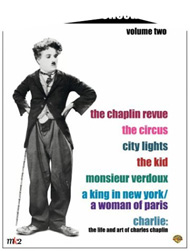
|
The Chaplin Revue, The Kid, A Woman of Paris, The Circus, City Lights,
Monsieur Verdoux, A King in New York, Charlie - The Life and Art of Charlie Chaplin Warner Home Entertainment B&W / Street Date March 2, 2004 99.92
|
This second grouping of Chaplin films from Warners, organized and produced by the Chaplin estate itself, finishes off the deep resources of the Chaplin family vaults. Besides adding a couple more masterpieces to the stack, this collection contains several of Charlie's odder experiments, his so-called failures, a collection of short subjects, and a new documentary by Richard Schickel.
The collection part one is one filmic triumph after another, and some of part two deals with problem releases of one kind or another. A Woman of Paris was considered immoral, and Monsieur Verdoux was taken as an insult to America by media-driven hysteria. By the time the openly critical A King in New York came out, it couldn't even be distributed in the United States.
This pair of collections has been criticized, and somewhat rightly so, for the versions of the films it presents. Set #1 gave us Chaplin's narrated, recut The Gold Rush, but wisely included the entire silent original version. Almost all of the films here seem to have been subjected to Chaplin's late-career tampering -- adding music to the silents, trimming scenes here and there. Lots of little details like scenes focusing on the mother's feelings in The Kid, or a peppy nightclub song in A King in New York, are shown here separately under the headline of deleted scenes. In this way Chaplin was the original George Lucas. Don't be frightened by the misleading info on the back of the boxes - A Woman of Paris says the deleted shots total 6 minutes, but that's only after they've been repeated so we can see how they fit into the film. There's probably less than 90 seconds actually clipped from the feature.
The films were also all transferred, edited and mastered in Europe in the PAL system. When converted to NTSC, audio pitch was corrected but the images still run about 4% faster than they should. The sound-era titles all seem too fast, until one adjusts. This has led many DVD buyers who invested in the earlier Image series of releases to decide to stick with them, even though they don't look nearly as bright or sharp as these copies straight from Chaplin's archives.
The big reason to grab these collections are the exhaustive extras that come with each disc. By far the best bonus on every disc is a brisk and to-the-point essay docu by David Robinson, one of the better English critics. He openly sides with Chaplin against America in the McCarthy years and gives the impression that he really knows his stuff.
Not as good but often amusing are the lengthy Chaplin Today episodes on each disc that interview to varying success odd assortments of people and modern directors. They tend to be too long - I didn't finish all of them.
Each disc also contains a few random sections of home movies and other errata, some of which one has to read the box text to understand why they are included. These tend to be hit and miss - anything with Chaplin home movies, especially his cute kids, is good, but there's a lot of filler, such as some dank, boring home movies of Paris in the 1920s that are simply difficult to sit through.
Some of the docus utilize a very irritating sepia treatment of photos. Shadows fall over them intentionally, as if some cockeyed French art director wanted to make a personal fashion statement. Very annoying. But most of the thousands of visuals here are fascinating.
On a final note, some of the discs below are in single packs and others double, but all are packaged in fairly flimsy card boxes. The folding sleeve for Verdoux is particularly weak, and tends to come apart the moment one tries to re-insert the disc holder. This is one set that needs to be stored together in its outside box, just to keep it from being damaged.
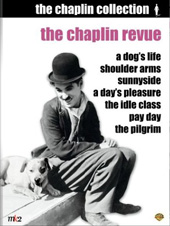
|
The Chaplin Revue 1918-21 / 1:37 flat full frame / 214 min. / 29.95 Written, Produced and Directed by Charles Chaplin |
Putting Chaplin's pre-feature work into an understandable shape is no easy task, as he was incredibly prolific and moved from studio to studio. This collection starts in 1918 when Chaplin built his own headquarters in an Orange Grove-dominated Los Angeles. The difference is immediate and dramatic - the sets and lighting have improved and the stories are more like mini-features than strings of gags.
Three of the first films were compiled and called The Chaplin Revue. That show included some gag snippets with visitors and extraneous shots of his studio that had never been publicly shown. We see Charlie giving up his cane to work with an animal in one short, and otherwise morphing his Tramp character into various modes to try out comedy alternatives - harried working man, father to an unruly family, millionaire playboy. Shoulder Arms took the risk of applying comedy to a war theme, and was filming before hostilities ended. It succeeds by not trivializing the conflict, and actually comes off as a better than average war film. All of the pictures are superior; my favorite is Sunnyside, a rural idyll that takes the Tramp away from his usual impoverished and brutal urban habitat.
The extras on this two-disc set begin with authoritative introductions from David Robinson, who knows the Chaplin history inside out. As the production of these shorts coincided with work on The Kid, there is some overlap in the historical details - another romantic mess to contend with, bouts of depression, trips made to charge the batteries. The "How to make a Movie Studio" short subject is repeated, along with hilarious scenes cut from Shoulder Arms showing Charlie as a civilian. There's a long series of "tour films" involving the visits of dignitaries. A Prince from Denmark (hmmm...) plays a role in a little skit, but the best of the shorts is one with the Bishop of Birmingham. He watches in his WW1 uniform while Charlie tries to ride a ridiculous giant bicycle.
Also included is the short propaganda film The Bond in which Charlie uses some shrewd (and restrained) comedy to help sell war bonds. I imagine that audiences went nuts when they saw their Tramp hero approaching The mustachioed Kaiser with a huge mallet, while the Statue of Liberty looks on.
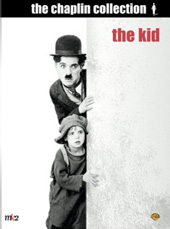
|
The Kid 1921 / 1:37 flat full frame / 68 50 min. / 29.95 Starring Charlie Chaplin, Edna Purviance, Jackie Coogan, Carl Miller, Lita Grey Cinematography Roland Totheroh Art Direction Charles D. Hall Original Music, Written, Produced and Directed by Charles Chaplin |
The Kid is one of Chaplin's most successful projects, mainly because of the terrific teaming with tiny Jackie Coogan. The sentimentality is unabashed but honest, and (especially in the pre-cut version) Chaplin shows as much sympathy for The Kid's sad mother as he does for his Tramp character.
At first the abandoned baby is a problem, but The Tramp grows into a protective and devoted father substitute. The strongest audience moments are those where Charlie becomes aggressive and even violent to defend his child against heartless orphan authorities. One can feel one's blood pressure rise.
There's also a charming angelic dream sequence that might come from one of his inspired short subjects.
The Kid is the obvious model for dozens of male bonding films later on, like The Champ and even Kramer vs. Kramer. Coogan's never really been bettered.
The Kid's double-disc set contains a ton of extra content. David Robinson's introduction remains the most concise source of info. Alain Bergala's Chaplin Today runs far afield, interviewing Iranian director Abbas Kiarostami for Chaplin's influence.
The deleted scenes yanked by Chaplin for his rescoring in 1971 are really important, showing The Kid's mother Edna Purviance wracked by guilt.
There's an entire second silent film (in so-so condiiton) My Boy starring Jackie Coogan. Also Chaplin's short subject on the making of his studio, a setup where Chaplin gets Coogan to dance at his studio, a home movie with Chaplin, Coogan and Lord and Lady Mountbatten, European vacation newsreel footage, a newsreel of Coogan visiting Paris, and a short bit showing Chaplin recording his 1971 score. This title is a fat disc set on its own.
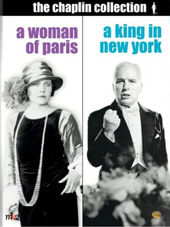
|
A Woman of Paris 1923 / 1:37 flat full frame / 78 min. / 29.95 (with A King in New York) Starring Edna Purviance, Carl Miller, Adolphe Menjou Cinematography Roland Totheroh Art Direction Arthur Stibolt Film Editor Monta Bell Original Music, Written, Produced and Directed by Charlie Chaplin |
This is Chaplin's odd-man-out picture, a sophisticated drama featuring his frequent costar in short subjects Edna Purviance. It's exceedingly well-made and uses Chaplin's behavorial talents to create characters that communicate without extreme gestures. It's also unusually fair to its characters, who are observed but not judged. Nobody is pure of heart, parental love is a destructive force and the ostensible villain, an honest womanizer, does no real harm.
Even the coincidences are minimized so that the concluding tragedy never seems like a set-up. Chaplin does add a clever joke to enliven his ending - when Marie's adopted kids run to the door to greet "Father," he turns out to be a priest.
David Robinson's introduction, as always, nails the conspicuous forces at work in A Woman of Paris and sketches out Chaplin's personal situation at the time. The Chaplin Today docu is also interesting but overlong.
Other extras vary in interest. The complete newsreel footage of the United Artists' signing ceremony is here, in perfect shape. It includes a lot of clowning by the principals (after D.W. Griffith apparently took his leave) that's great fun to watch, especially when Mary Pickford and Douglas Fairbanks hoist Charlie up in the air.
Ten minutes of dark home movies from Paris of the 1920s are a bore, and so is a vanity home movie by Ralph Barton starring all of his high-toned friends, including a raft of famous authors. Useful only to see the likes of Sinclair Lewis hamming it up for a pal.
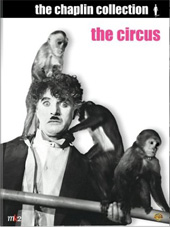
|
The Circus 1928 / 1:37 flat full frame / min. / 29.95 Starring Chaplin, Al Ernest Garcia, Merna Kennedy, Harry Crocker, George David Cinematography Roland Totheroh Art Direction Charles D. Hall Edited, Original Music, Written, Produced, Directed by Charles Chaplin |
The Circus is supposed to be one of Charlie's less "accomplished" features, probably because it hasn't got a big hook to it like so many of the others - City Lights is more perfect as a tearjerker, Modern Times is full of political comment, etc. What The Circus does have is a lot of almost perfect comedy with the Tramp in straight old-fashioned form. He escapes the law and gets a tryout with a troubled big top. The ringleader mistreats his clowns and his daughter for not filling the stands with laughing people, and Charlie "accidentally" causes a laugh riot.
The Circus actually does have something fairly unique in that Charlie frequently interacts with animals, which is not an easy thing to do. We think of those home movies of him feeding the monkeys in Bali as we watch him suffer an onslaught by a veritable barrel-ful while trying to do a high wire act. They're climbing in his face, biting his nose and it's a nightmare.
Charlie shows the fine subtleties of his gags by making fine distinctions between being funny but not trying to be funny, and trying to be funny and not being funny. We know it immediately. When the Tramp auditions his "amusing" ideas, everyone, including us, just sits there waiting for laughs that don't come. This must have required some thought from Chaplin, as his main genius was the ability to be fall-down funny on a moment's notice, effortlessly. The Tramp reaches a high form of expression here - he's the generic funny guy, without the additional baggage of social comment or high dramatics. It's hugely enjoyable. Like so many of these pictures, you come home tired and in a sour mood, turn on the show, and a minute later you're laughing and feeling better.
The extras on the second disc with this movie have the expected Chaplin Today and David Robinson entries, plus some fairly unique material. There's an entire circus-themed Jackie Coogan movie, and some interesting 3D camera tests by Rollie Totheroh. There is also a set of outttakes from a week's shooting that don't back up the idea that Chaplin was supposedly depressed and suffering during production. Clearly his troubles hit him after he closed down for the day.
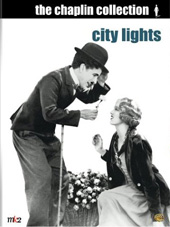
|
City Lights 1931 / 1:37 flat full frame / 86 82 min. / 29.95 Starring Chaplin, Virginia Cherrill, Harry Myers, Hank Mann, Florence Lee Cinematography Gordon Pollock, Roland Totheroh Original Music Charles Chaplin and José Padilla Edited, Written, Produced and Directed by Charles Chaplin |
City Lights is my favorite Chaplin film, the one where he falls in love with a blind girl who thinks he's a rich benefactor because he keeps doing risky things to earn enough money for her eye operation. The story is just a pretext but the emotions seem more honest than ever. The Tramp here is still the unpredictable, not-always-sociable scamp from the silent days, capable of minor malice as well as sentimentality. And there's not a message in sight.
This is the film where his efforts resulted in superior work, creating sequences that were practically perfect. When we're told he performed scenes hundreds of times looking for the right combination of action and emphasis, it's a marvel that the final takes look so fresh. When Chaplin goes for the sentimental, it's entirely personal - the conclusion is one of the best pieces of film ever shot, and the perfect expression of his personality.
Chaplin considered other actors to be almost puppets, and they'd have to have amazing patience to redo scenes dozens of times. Leading lady Virginia Cherrill apparently had independent ideas (oh no!) and didn't see eye to eye with her director, which helps the show. Paulette Goddard in the next two films seems far too eager to please, just an extension of Chaplin's ego, and there's no conflict. Here The Tramp's vulnerability is heightened by the disconnect ... we don't get the idea that Cherrill is there because she's sleeping with the boss.
There are two apocryphal stories about City Lights, and this disc clears up one of them. Some sources (or perhaps a confused UCLA professor) used to say that two separate actresses played the blind girl, which I believed for some time. Perhaps that was confusion over Charlie's testing of an earlier actress for the same part - her screen tests are in the extras on the second disc. Second, everyone assigns the credit to Charlie for the picture's musical score. The main theme is La Violetera ("The Flower Girl"), a Latin American standard from years before. Chaplin's scoring is fine, but he didn't write that classic melody.
City Lights has plenty of interesting extra material. The introduction by David Robinson explains the basic situation with the film and its place in the Chaplin filmography, and the Chaplin Today piece by Serge Bromberg goes off on pleasant tangents. One of the founders of Aardman animation is interviewed on the subject of Chaplin as a key source for animated comedy. There's an entire 1915 short about a prize fight that's reminiscent of the one in the feature, and a lengthy assemblage of Chaplin clowning with various prizefighters. Also some footage of Winston Churchill visiting the studio (nothing happens so Chaplin improvises a dance; Winston just stares and smiles).
In a sound fragment shot in Vienna we see Chaplin being mobbed, and then saying "Guten tag." There are also extensive home movies of a trip to Bali. The best extras are uncut footage of rehearsals and alternate takes on many scenes, and a deleted scene where The Tramp encounters a piece of wood stuck in a sidewalk grating. A really odd fragment is a costume test for Chaplin as a dream prince, the way the flower girl of City Lights imagines him to be.
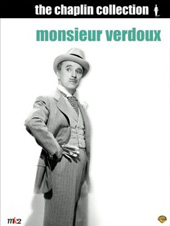
|
Monsieur Verdoux 1947 / 1:37 flat full frame / 119 124 min. / 24.98 Starring Chaplin, Mady Correll, Marilyn Nash, Martha Raye Cinematography Roland Totheroh Art Direction John Beckman Film Editor Willard Nico Written by Charles Chaplin from an idea by Orson Welles Original Music, Produced and Directed by Charles Chaplin |
This is the picture that cooked Chaplin's goose in America. Just as the dogs of McCarthyism, puritanical backlash and Cold War paranoia were being set loose, Charlie made this uncompromising, definitive black comedy. He was attacked for his paternity-suit problems as well as his humanist politics. In response to the horrors of WW2, Chaplin decided to indict mankind by equating the activities of a mass murderer killing for profit ("Business, just business") with the actions of governments and elected officials.
1947 was not a good year to disturb American political waters. Blacklisting was just getting under way, and although Chaplin was far too rich to be subpoenaed directly, he made an excellent target for espousing liberal causes and never taking American citizenship. Not realizing how anxious the media were to attack, he dropped the Tramp character and played an unrepentant atheist who dares turn society's hypocrisy back on itself. It's polite, simple and cold-blooded, the definition of good black comedy.
All in all, it's expertly done, although not a laugh riot. Martha Raye is terrific, and the Girl that Verdoux identifies with contributes some quietly chilling scenes. With all the thugs in the world "getting paid for their killings, with the law's arms around" them (to quote Peckinpah), Chaplin's elegant reasoning cuts deeper than the sentimental polemics of his Modern Times and The Great Dictator. It's the original black comedy that dares to offend, and dares to fling the audience's ignorance back in its face. James Agee still makes the best reading on Monsieur Verdoux. I once saw an LA Times movie section from 1947 to look at what was playing in town then - films like Captain from Castille. But in only a few pages, there must have been three venemous editorials against Chaplin, practically calling him Satan and encouraging his deportation. The same mad dogs screaming for his hide would later call him a paranoid for "imagining" that the U.S. was out to get him.
David Robinson really lays into the U.S. in his brief and effective intro installment. The Chaplin Today by Bernard Eisenschitz uses French director Claude Chabrol to try to make a case of Monsieur Verdoux as a superior thriller, but Chabrol tends to praise relatively generic camera moves and setups as inspired art. He does seem personally convinced, however. Otherwise, there's not much for goodies here - I guess the theatrical boycott and other outrages didn't inspire Chaplin to accumulate a lot of keepsake footage. We make do with some set plans, and the expected excellent selection of photos and trailers.

|
A King in New York 1957 / 1:37 flat full frame / 78 min. / 29.95 (with A Woman of Paris) Starring Chaplin, Dawn Addams, Michael Chaplin, Maxine Audley, Oliver Johnson Cinematography Georges Perinal Production Designer Art Direction Film Editor Original Music Charles Chaplin Written by Produced by Directed by |
This is the newest film in the collection, and Chaplin's second-to-last. His A Countess from Hong Kong is a fossilized curiosity that's painful to watch, but A King in New York shows Chaplin making his satiric points with uncommon accuracy. Previously he dealt with political problems almost abstractly, and here he calls things by their real names. His king is a convenient witness to the madness Chaplin has decided has seized America. The U.S. is a civilization in collapse under the weight of commercial hype and political paranoia.
Most of it works, even through the flat lighting and inadequate London stand-ins for New York, where Chaplin could not return after having his passport revoked by vindictive government officials in 1952. A lot of the English actors, like Sidney James' publicity , do excellent American accents. (James did much the same in the equally subversive Christ in Concrete.) Much of the satire is spot-on, especially Shadov's revulsion at TV commercials and his brilliant parody of theatrical trailers that show America to be psychotically obsessed with violence. He's tricked into performing in front of a hidden camera, thus predicting the future of "reality" programming. He also gets in a few licks on other subjects like progressive schools and intrusive newsmen, and the American lust to commercialize everything in sight.
Chaplin's son does a good job playing a traumatized kid obviously meant to be a stand-in for the children of the Rosenbergs, whose execution for spying Chaplin deplored. In an interesting twist on the Tramp's knack for charming kids, this dark-eyed fellow has his spirit broken by the inquisitors of the McCarthy committees, who trick him into naming the names of his parents' friends, people who in the past had belonged to the Communist party.
The slapstick is what lets the film down the most. The forward motion is constantly interrupted for gag routines, such as a nightclub act modeled after Chaplin silents or tiresome antics with a fire hose in a hotel elevator. These drag down the better material, such as the sublime moment when the visiting King praises American hospitality - while customs officials fingerprint him.
A King in New York looks okay but is presented flat when it was meant to be projected at at least 1:78 (which is how I saw it on its offical U.S. premiere in the early 1970s. It crops off well on a widescreen monitor but is going to have acres of head and footroom on a normal screen.
The Chaplin Today piece goes over the same ground covered by David Robinson's introduction and adds two interviews. Michael Chaplin can't be much older than I am, but looks pretty worn out as he describes working with his father. Director Jim Jarmusch gives his views on Chaplin's politics but isn't very compelling or organized in his thinking.
Several of the deleted scenes I remember seeing theatrically, and they're missed. The peculiar nightclub song shouldn't have been dropped, as it's a great counterpoint to the phony Rock'n Roll number in the movie theater, the one that has the harsh attack of These are the Damned's song Black Leather Rock. Mandolin Serenade shows Chaplin conducting a rehearsal of one of his musical compositions for the film (they're not bad at all). Chaplin credits an arranger and a conductor in the film credits themselves.
|
Charlie - The Life and Art of Charles Chaplin 1977 / 1:37 flat full frame / 133 min. / only available in boxed set Starring Woody Allen, Sydney Pollack, Geraldine Chaplin, Johnny Depp, Robert Downey, Jr, Milos Forman, Norman Lloyd, Marcel Marceau, David Raksin, Martin Scorsese Film Editor Bryan McKenzie Original Music Charles Chaplin Produced by Douglas Freeman, Bryand McKenzie, Richard Schickel Written and Directed by Richard Schickel |
Richard Schickel's lavish docu on Chaplin's life is going to be diminished somewhat by its placement here, even though as a stand alone it would be excellent. Most of the behind-the-scenes footage is the exact same MK2 Chaplin-vault material that is added uncut on the Chaplin collection discs, so if one has just finished watching the set, it's all going to look too familiar. Then again, just seeing Charlie play a ham ruining some film coverage of a soapbox car race from his first film is quite a treat.
Covering all of Charlie's life and films in just over two hours isn't easy, and the analysis also plays like a digest version as well. Some films, like A King in New York and A Countess from Hong Kong are almost ignored, and the cruel baiting of Chaplin by the media is dismissed with a few phrases like "Chaplin lost his audience" and "once in Europe, Chaplin consorted with fellow travellers." The (conservative?) Richard Schickel can certainly call the comedian his own worst enemy with his paternity suit problems, etc., but painting him as somehow guilty as charged by the commie-hunters doesn't go down well. The self-centered Chaplin was as "non-aligned" as a dinner-table politico can be.
Otherwise, Schickel's attention to the comedian's style and genius is rewarded with several moments that might persuade nonbelievers to become Charlie Chaplin fans. The docu is littered with dozens of celebrity interview comments that help sell projects but are less rewarding than they might be. Various actors do little more than gush over their hero (they all watch Chaplin all the time, and have life-changing epiphanies over him!). Woody Allen repeats the same message at least twice, but Martin Scorsese is unusually relaxed and communicative about specific shots in specific films.
The Chaplin family members do well but there are no great surprises in that category. Schickel avoids empty sentimentality, and mostly does the comedian justice.
The docu appears to have been assembled in America on film, which makes me wish I could place the film clips side by side with the other collection discs, to see if they're really running at the proper 24fps speed. The Life and Art may be the only disc here where Charlie Chaplin's work runs at the correct frame rate!
On a scale of Excellent, Good, Fair, and Poor,
The Chaplin Revue (2 discs) rates:
Movie: Excellent
Video: Excellent with the on-going PAL frame-rate issue
Sound: Excellent
Supplements: Introduction by David Robinson, The Visitors Behind-the-scenes
footage of visitors to Chaplin's sets Harry Lauder (1918), Footage that Chaplin and
the great British Music Hall comedian shot for an uncompleted short, Photo gallery,
film posters, How to Make Movies (1918) short film in which Chaplin shows the building
of his new studio, The Bond (1918), WWI propaganda film featuring Chaplin, his brother
and Edna Purviance, Shoulder Arms deleted scenes, Photo gallery, film posters
The Kid (2 discs) rates:
Movie: Excellent
Video: Excellent with the on-going PAL frame-rate issue
Sound: Excellent
Supplements: Introduction by David Robinson, Chaplin Today: The Kid
Documentary by Alain Bergala, How to Make Movies (1918) short film in which
Chaplin shows the building of his new studio, and how movies are made there;
Jackie Coogan Dances (1920) Jackie Coogan performs impromptu dance at
Chaplin studios My Boy (1921), later film starring Coogan Nice and
Friendly (1922) home movie with Lord and Lady Mountbatten, Jackie Coogan and
Charles Chaplin, Charlie on the Ocean (1921) Newsreel footage of Chaplin's
first trip back to Europe Jackie Coogan in Paris footage shot during
charity fund-raising trip, Deleted scenes: three scenes deleted by Chaplin for 1971
reissue; Recording the new score footage of Chaplin conducting a section
of his new score, Photo gallery, film posters, trailers
A Woman of Paris (1 disc packaged with
A King in New York) rates:
Movie: Excellent
Video: Excellent with the on-going PAL frame-rate issue
Sound: Excellent
Supplements: Introduction by David Robinson, Chaplin Today: A Woman in Paris
Documentary by Mathias Ledoux, Camille 1926 An amateur movie by Ralph Barton
featuring numerous personalities of the time, Paris in the '20s, Images of the city
in the Roaring Twenties, United Artists signing the contract creating UA: Chaplin,
Mary Pickford, Douglas Fairbanks and D.W. Griffith, Deleted Shots, photo gallery, film posters,
trailers
The Circus (2 discs) rates:
Movie: Excellent
Video: Excellent with the on-going PAL frame-rate issue
Sound: Excellent
Supplements: Introduction by David Robinson, Chaplin Today: The Circus
documentary by Francois Ede; Deleted 10-minute sequence; October 7-13, 1926
Outtakes from a week of shooting; Three home movies from the archives of Lord Louis
Mountbatten; The Hollywood Premiere (1928), Reportage on the L.A. premiere;
Camera A, Camera B, shots made simultaneously from the two cameras used; 3-D
Test footage by Roland Totheroh; Excerpts from Circus Day with Jackie Coogan
-- an adaptation of a favorite children's book; Photo gallery, film posters, trailers
On a scale of Excellent, Good, Fair, and Poor,
City Lights(2 discs) rates:
Movie: Excellent
Video: Excellent with the on-going PAL frame-rate issue
Sound: Excellent
Supplements: Introduction by David Robinson, Chaplin biographer,
Chaplin Today: City Lights Documentary by Serge Bromberg;
The Champion (1915), excerpt Georgia Hale screen test, Virginia Cherrill
rehearsal footage, outtakes, on-set footage of scene being shot; Footage of
Chaplin boxing with visiting prizefighters on the set; Historical footage of
Winston Churchill visit; Footage shot on trip to Bali with brother Sydney;
Chaplin Speaks! Chaplin speaks for the first time on film during a 1931
trip to Vienna Photo gallery, posters, trailers
Monsieur Verdoux (1 disc) rates:
Movie: Excellent
Video: Excellent with the on-going PAL frame-rate issue
Sound: Excellent
Supplements: Introduction by David Robinson, Chaplin Today: Monsieur Verdoux
Documentary by Bernard Eisenschitz, Plan drawings and preparatory sketches, Photo gallery,
film posters, and trailers
A King in New York (1 disc, packaged with
A Woman of Paris) rates:
Movie: Excellent
Video: Excellent with the on-going PAL frame-rate issue
Sound: Excellent
Supplements: Introduction by David Robinson, Chaplin Today: A King in New York
Documentary by Jerome de Missolz, Deleted scenes, Mandolin Serenade: Rehearsing one of
the film's main musical themes, Photo gallery, film posters, trailers
Charlie - The Life and Art of Charles Chaplin (1 disc) rates:
Movie: Very Good
Video: Excellent
Sound: Excellent
Supplements: none
Review Staff | About DVD Talk | Newsletter Subscribe | Join DVD Talk Forum
Copyright © DVDTalk.com All rights reserved | Privacy Policy | Terms of Use
|
| Release List | Reviews | Price Search | Shop | SUBSCRIBE | Forum | DVD Giveaways | Blu-Ray/ HD DVD | Advertise |





